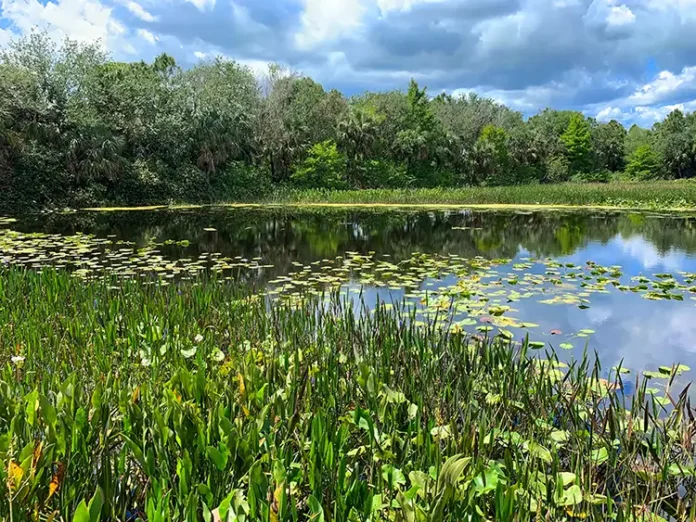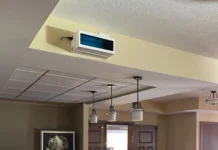Liz Stevens, writer, UV Solutions
At the 2022 IUVA Americas Conference, Jennifer Osgood of CDM Smith presented a paper, coauthored by Dave MacNevin, entitled, “Reuse Innovation with UV Advanced Oxidation.” The paper discussed details of Florida-based Palm Beach County’s Green Cay Phase 2 Project, overseen by the Palm Beach County Water Utilities Department, to expand the existing Green Cay Nature Center with a water purification plant, a learning center focused on water conservation and acres of new wetland habitat open to the public for birdwatching, hiking, canoeing and fishing.
The new domestic wastewater purification plant, located at the Southern Region Water Reclamation Facility (SRWRF), will have a two-million-gallon-per-day (MGD) capacity (expandable to 4 MGD) to treat water, which then will be piped to lakes in Green Cay Phase 2, thereby returning the water to the area’s aquifer. CDM Smith, a global engineering and construction company headquartered in Boston, Massachusetts, is handling the project, which began in early 2022 with pilot testing. UV Solutions spoke with CDM Smith’s Jennifer Osgood about the ongoing project.
The treatment steps for the new water purification plant include ultrafiltration and reverse osmosis (RO), breakpoint chlorination (BPC) and UV advanced oxidation (UV AOP). “What is notable about the wastewater effluent of SRWRF is that it is non-nitrified,” said Osgood. “That has important implications for UV AOP treatment and can make it more difficult.”
Hydranautics HYDRAcap MAX60 and Toray HFUG2020AN equipment for ultrafiltration were used, with the two units providing similar filtered water quality. Two treatment trains were tested for reverse osmosis – Hydranautics ESPA2-LD-4040 and Toray TMG10D, running in parallel to allow for comparison of the products. The net removal of ammonia nitrogen by the reverse osmosis membranes was 92%.
In between the reverse osmosis step and breakpoint chlorination, the pH of the water was increased in order to stabilize the water, to speed up the breakpoint reaction,and to minimize formation of N-nitrosodimethylamine (NDMA), a drinking water contaminant of concern because of its carcinogenicity and toxicity. “We found that pH of 7.5 was more or less the optimum level,” Osgood said. “It provided the best kinetics and the most effective reaction.” She explained that minimizing NDMA formation is a common objective for UV photolysis. “NDMA might be formed during breakpoint chlorination,” said Osgood, “but the UV AOP step removed it below detection limits.”
Breakpoint chlorination was included, said Osgood, “to meet strict Class III Surface Water Quality Standards for ammonia nitrogen. For the temperatures tested, the ammonia criterion would range between about 0.3 to 0.1 mg/L as N, for a pH between 8 and 9 with stricter limits at higher pH.” This treatment step met the ammonia goal while also increasing UV transmittance to 100% which, without BPC, was 96% +/- 2.5% (+/- 1 Standard Deviation).
The project tested UV advanced oxidation with both UV-peroxide and UV-chlorine. “UV-peroxide, after breakpoint chlorination, delivered superior results,” Osgood explained. “Because of the need to increase the pH for breakpoint chlorination, UV-peroxide was much more effective. UV-chlorine proved to not be a good fit for this application.”
Following UV AOP, oxidant quenching and calcium stabilization steps were employed. “Oxidant quenching,” said Osgood, “is a standard approach before surface water augmentation. Florida’s Class III surface water quality criteria require total chlorine less than 0.01 mg/L.” The purified water then undergoes calcium stabilization before being piped to the lakes and eventually contacting local limestone in the area’s surficial groundwater aquifer.
Osgood summed up findings of the project so far that may inform future projects. “This project is significant because it showed the effectiveness of BPC to remove ammonia nitrogen in reverse osmosis permeate. RO permeate is relatively free of total organic carbon; thus, carbonaceous disinfection byproduct formation is much more limited than in other cases where BPC would be applied in water treatment.”
Green Cay Phase 2 is expected to start construction in early 2024.
For more information, visit https://www.cdmsmith.com/en/Webinar/Water-Reuse-to-Meet-Future-Water-Supply-Needs






